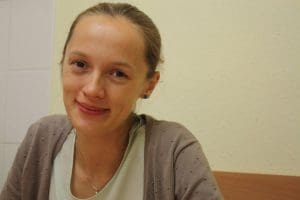
Magdalena Garbacik-Balakowicz
Students of Hungarian language and literature tell why they keep coming back to Debrecen University Summer School
By James Brewer
Success stories are recorded every year by the students who attend Debrecen University Summer School, which gives people from dozens of countries the opportunity to steep themselves in Hungarian language and culture.
The majority of people on the two- and four-week courses are beginners or intermediate learners of the Hungarian language who, thanks to first-class tutors, pick up sufficient skills needed to win a diploma at the conclusion of their studies.
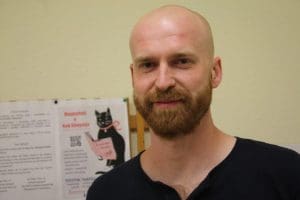
Jiří Januška.
Several have impressive achievements built on their enthusiasm for the challenge. Possibly the only attendees engaged in PhD research in Hungarian philology, focused on linguistics and literature, in the recent sessions were Magdalena Garbacik-Balakowicz from Poland, and Jiří Januška from the Czech Republic. They told us how they came to be involved in such a thorough exploration of disciplines related to the Hungarian tongue, and of the benefits they were gaining from the two week courses of advanced tuition offered by Debrecen.
Both have attained C2 level, a status under what is called the Common European Framework. This is a European Union measure of skill denoting that they are proficient in the language for academic and advanced-level purposes, with spontaneous and fluent expression and the ability to differentiate fine shades of meaning. Among their additional array of language knowledge, Magdalena and Jiří possess an excellent command of English.
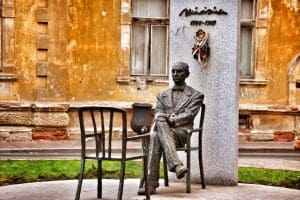
Statue of writer Sándor Márai in Košice.
Magdalena Garbacik-Balakowicz, known to her friends as Magda, hails from Kraków. She studied philosophy at Kraków University, and after three years decided to learn a language new to her. “I read some Hungarian writers in Polish and decided to go deeper into their background.” As part of this investigation, Magda took a special course in Hungarian studies at the Kraków, which is one of the centres of Hungarian studies in Poland, in addition to Warsaw and Poznań.
Magda has two master’s degrees, in philosophy and Hungarian philology. “I should like to make my PhD about writers, in particular Sándor Márai, ” she said.
Sándor Márai (1900-1989), who wrote 46 books, mostly novels, is considered one of the most influential representatives of Hungarian-language literature between the world wars. His 1942 book Embers (its Hungarian title A gyertyák csonkig égnek means The Candles Burn Down to the Stump) expresses a nostalgia for the bygone multi-ethnic, multicultural society of the Austro-Hungarian Empire. Hewas the first author to write reviews of the work of Franz Kafka.
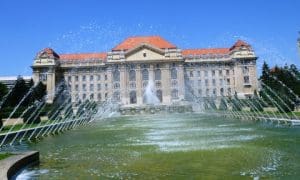
Making a cultural splash: Debrecen University.
Márai was born in Kassa in Austria-Hungary (now Košice in Slovakia). He was “profoundly anti-fascist, ” a dangerous stance in wartime Hungary; nor did he like the Communist regime that took power after World War II, and left – or was driven away – in 1948, never to return.
Márai’s Memoir of Hungary (1944-1948) provides a glimpse of post-war Hungary under Soviet occupation. He settled in San Diego, California, continuing to write in his native language, but after the death of his wife, retreated into isolation, and committed suicide. The novelist Tibor Fischer in the New York Times SundayBook Review in 2007 wrote: “He loved his native language, and stuck with it in exile (he could easily have switched to German) although he was well aware this decision ensured indigence and obscurity.”
Magda looks forward each year to travelling to the Summer School to immerse herself in the language and to meet old friends and drink a glass of Hungarian wine.
“The school is wonderful: it has a long tradition, more than 90 years of teaching Hungarian, ” she said. “The people here are great. It is not only language and culture that we experience, but the people.” She sees her future in academia and later as a professional translator.
Jiří Januška of Prague is working towards his PhD in linguistics.
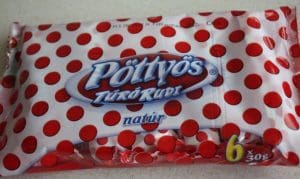
Favourite chocolate bar: túró rudi, this one made by Pöttyös.
One might say that Jiří has a romantic attachment to the Hungarian language: he had started to study general linguistics, when he fell in love with a Hungarian girl. “After a couple of weeks, it turned out that she was not in love with me, but I started to learn Hungarian because I was a student of languages, ” he said.
“I found Hungarian very interesting from a linguistic point of view and decided to take Hungarian studies in Prague. Then I fell in love with the language. This is my fourth time in Debrecen – twice as a student and now the second time as a teacher at Prague University.”
Jiří’s aim is to pursue an academic career in linguistics.
Magda said that there were some touching stories involving people who attended the summer school. “One woman attending the school found out only late in life that she was born in Hungary. She had lived a long time in Belgium. Last November she received Hungarian citizenship.”
One of the incidental benefits for Magda and many of her friends of visiting Hungary is that they can stock up on a favourite candy, túró rudi (túró meaning curd, and rudi meaning bar and a reference to the name Rudi, short for Rudolf). One of the top brands is Pöttyös (which means polka dots). The bars are a delicious chocolate-covered combination of fresh quark, and various fillings, including fruity jam.
Such treats make a stay in Debrecen that much sweeter.





